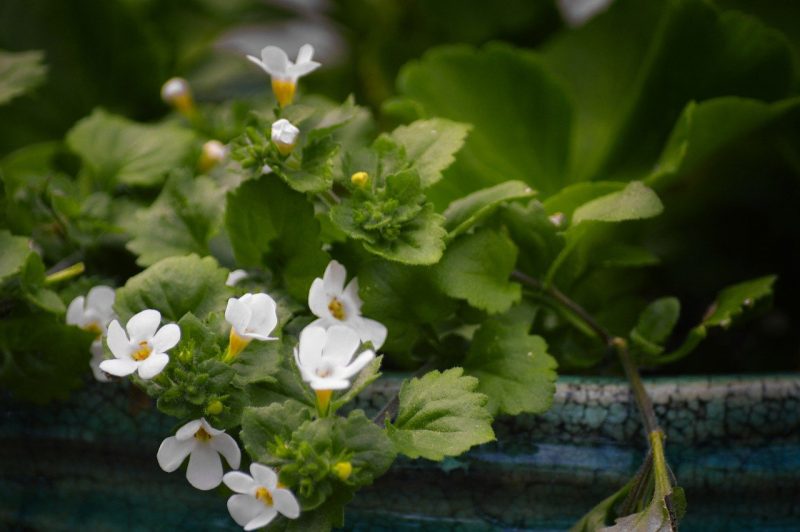There are two methods for you to learn how to propagate bacopa. You can either start from seeds or cuttings, but either technique is relatively easy to do. Nonetheless, starting any plants would be more comfortable in the greenhouse until they have established themselves for outdoor transplanting.
Being comfortable with propagating bacopa will always be advantageous as this is an annual plant. You want to make the most of your existing bacopa plants by rooting cuttings. On the other hand, knowing how to germinate and start bacopa from seeds can be beneficial if you don’t have mature plants yet.

How To Propagate Bacopa: Easy To Follow Guide
Seeds
The first propagation method for bacopa plants is from seeds. Not all gardeners prefer this method because, unlike rooting from cuttings, starting bacopa from seeds create smaller flowers. More so, you can’t guarantee the plant’s resulting characteristics, so those who have specific varieties in mind should consider propagating from cuttings.
Step #1. Sowing
You also want to check what bacopa variety you’re growing and see if they can start from seeds. Be aware of what these seeds look like and consider starting them in the greenhouse in late winter. You can use any container for sowing bacopa seeds, but you don’t have to bury or cover them with soil.
Step #2. Maintaining
Gardeners typically use a moist compost and then mist the soil once more after sowing. To further help with sprouting, cover the container with a plastic bag. Place them somewhere bright but out of direct sunlight to avoid damaging the seeds.
The excellent news with bacopa seeds is that they should germinate within ten days. The stable conditions in the greenhouse should prevent any problems in sprouting. And once this happens, you can remove the plastic cover and thin the plants in the containers.
Step #3. Thinning and transplanting
You want to leave the strong seedlings to develop since the weaker ones can compete with the soil’s space and nutrients. Afterward, transplant them so that each pot will only have one bacopa seedlings. You can then acclimate the seedlings to the outdoor conditions and transplant them outdoors after the danger of frost has passed.
Cuttings
If you want to preserve a bacopa variety’s character, the best way to propagate them is via cuttings. You can use your existing mature plants, significantly trailing bacopas. The best time to take cuttings is in late summer, but you also have to ensure a few things.
Step #1. Collecting
First, the parent plant itself should be healthy so that it won’t get stressed after taking the cuttings. You also want to take disease-free cuttings around three inches long using a sharp and sterilized tool. This is necessary for a clean-cut and even prevention of disease transmission.
Step #2. Rooting
Remove the lower leaves of the section and dip the end in rooting hormone powder before planting them. Insert an inch of the end into a pot with a mix of vermiculite and sand, and ensure that it is stable. Much like growing bacopa from seeds, you can cover the pot with a plastic bag to help preserve moisture.
Step #3. Maintenance
You can place the cuttings somewhere bright but out of direct sunlight as well. For maintenance, check the potting mix regularly if it is still moist and mist them if necessary. You can expect root establishment after a month.
Step #4. Transplanting
You can plant the rooted cuttings in spring after the danger of frost. However, you must harden them first to prevent transplant shock. You can gradually put them outside for two weeks during the day before permanently transplanting them outdoors.
Growing and Caring For Bacopa
Location
Bacopas generally grow quickly and are not meticulous for their needs to establish themselves after you planted them. As mentioned in the two propagation methods, you want to produce the rooted plants after the frost’s danger has passed to avoid problems. You can check if your variety likes partial shade or full sun and choose a location accordingly.
Remember that some varieties would thrive well amidst high temperatures, while others should only have the sun for some hours in a day. What soil is best for growing bacopa? Fertile and well-draining soil is ideal for bacopa, and you can also get it tested as slightly acidic levels are also preferable.
Maintenance
Upon planting, wait for the plants to reach four inches in height and pinch the growing tips. This should encourage bushy growth, and you can just use your fingers to remove them by about ⅓ inches. You must also ensure that the plants themselves are hydrated to avoid problems in flowering.
Mulching is not necessary as this can encourage rot, but you can fertilize once every three weeks. Do this during the growing season with a liquid fertilizer. As time goes on, you may need to prune the plants in the middle of the summer to help them rejuvenate themselves and regrow better.
Conclusion
Plant propagation will always be useful for all gardeners alike. If you know how to propagate bacopa either from seeds or cuttings, you can quickly produce more of these plants, whether it’s for your hobby garden or profitable nursery. In both cases, you can benefit from starting the seeds and cuttings in the greenhouse and then place them somewhere bright but out of indirect sunlight.
Maintain soil moisture and wait for the plants to reach the appropriate maturity for transplanting. More so, check the specific needs of your bacopa varieties and adjust the practices accordingly.
